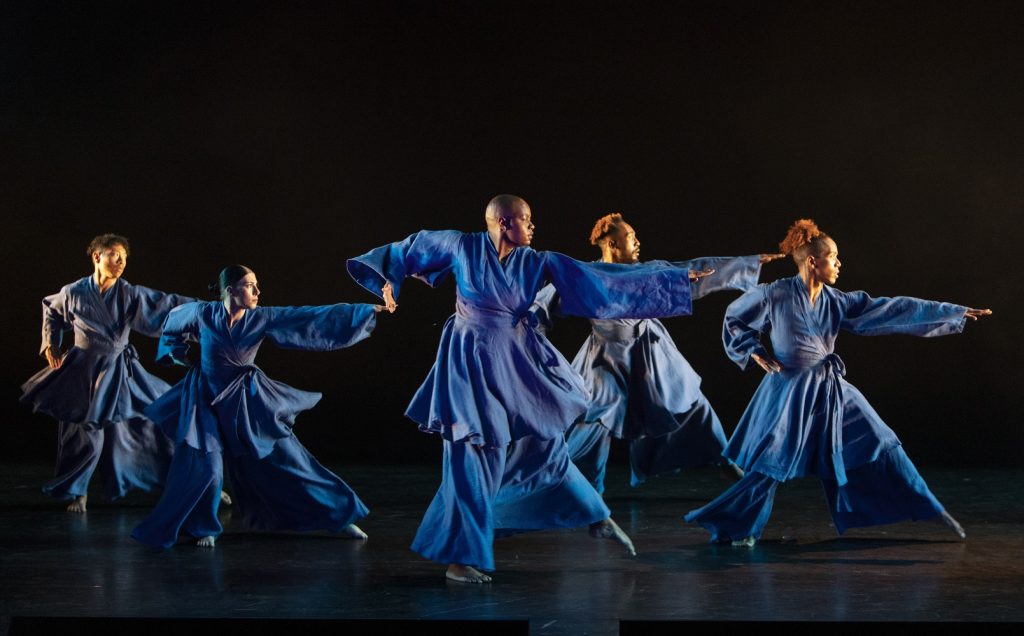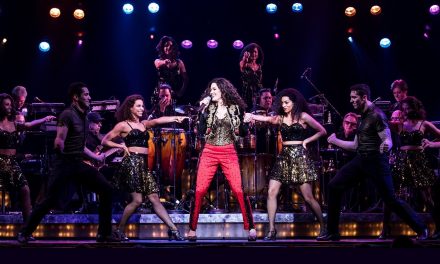Dance has returned to CAP UCLA’s Royce Hall. Ronald K. Brown brought his company “Evidence” to open the pandemic shuttered Hall after two long years. There was palpable excitement in the air as the guests were welcomed with a special exhibit of music, books, photos, speeches and archival materials relating to the performance. In particular was a past interview with activist, Angela Davis a former UCLA professor and the voice of choreographer Brown’s opening piece “The Equality Of Night and Day: First Glimpse.”
Brown was smart to enlist the accomplished jazz pianist and composer Jason Moran to score this meditation on the equality of night and day, the equinox. With the use of early Angela Davis speeches in which she speaks to “presumptions of family, community, democracy and justice” there is ample material for choreographic inspiration. Starting slowly with a pastoral feel the rising sun reveals the dancers in layered sapphire blue costumes, beautifully designed by Omotayo Wunmi Olaiya, to flow with the movement. The effective lighting design of the movement of the sun in a twenty-four hour day, was by Tsubasa Kamei.

Ronald K. Brown / EVIDENCE – “The Equality of Night and Day: First Glimpse” – Photo by Rose Eichenbaum
The choreography based in Afro-Cuban and jazz technique is not about precision rather about the feelings evoked. Brown’s intention to create “circles of meditation, of grief and protection” came through some of the time but the symbolism such as quivering hands, pointing index fingers and shedding of shirts, was often obscure.

Ronald K. Brown / EVIDENCE – “The Equality of Night and Day: First Glimpse” – Photo by Rose Eichenbaum
Initially I was intrigued by the simplicity and looseness of the staging. The dancers, led by the powerful Joyce Edwards, swayed and undulated while using sweeping arms, spins and leaps. Brown’s unique style is an interesting combo of hyper energetic movement in one moment and very laid-back movement in the next. The entire piece was filled with these highs and lows for example, the meditative walking circle drew me into its spell until it went on for too long, taking simple to the extreme. Yet when Angela Davis’s voiceover described the over abundance of young black men in prison, four male dancers burst forth in a very effective rush of physical frustration and anger. Then again, when the music changed from melodic piano to a highly charged electronic track, the choreography did not change with it, the focus got lost and the dancing went from loose to labored. The dancers work very hard and give the choreography their best effort but therein lays the problem; it feels effortful, without joy and more importantly without a connection to one another. As this is a work in progress perhaps these ups and downs will be rectified as more time is dedicated to a brilliant score and a good idea.
Created in 1998 “Upside Down” features the dynamic music of Oumou Sangare and Wunmi, both fabulous Nigerian singers. With accompaniment from contemporary and traditional instruments we are immediately connected to the landscape and the culture. Because there is a story here, “the loss of a community member, the gathering in solidarity and the final departure to ones true destiny,” we might expect to see strong interaction among the performers and a clear narrative but we do not. Though dancing side by side, it is as if each is alone on stage. The choreography starts slowly with simple isolations, rhythms and jazzy steps and builds to a pitch of constant movement when the drums kick in. With the Afro-Cuban feel the dancers jump, swoop, turn and dance nonstop in an aerobic marathon. There is no precision here and technique is elusive but with high-flying leaps and throwaway exuberance we are swept into a force field of energy. Exciting, yes, but more depth could be had if the storytelling went along with the movement. We only know that there is a death when a male dancer lies down on the floor for no apparent reason. Immediately he arises and joins the company as just another dancer until near the end when he lies down again and is picked up and carried out on the shoulders of the six bearers.
Dancing for the sake of dancing is perfectly fine, even great but when we are told that there is a story we expect to follow the narrative. This is lacking from Mr. Browns choreography, which leaves the viewer frustrated and unclear of his intention. “Upside Down,” can be more than energetic and I hope Mr. Brown will refocus and bring that potential to the light.
Well received by the audience the bows were met with a partial standing ovation. As the house lights went up and the background music filled the hall the dancers began to smile and dance together with joy and abandon. If only we had seen more of that.
The Company dancers are; Demetrius Burns, Stephanie Chronopoulos, Austin Warren Coats, Charles Grant, Breana Moore, Christopher Salango, Shaylin D. Watson, Guest Artist, Daniel S. Harder and the aforementioned Joyce Edwards.
The original lighting design was by Brenda Gray, recreated here by Tsubasa Kamei and Omotayo Wunmi Olaiya designed the costumes.
#####
To learn more about Ronald K. Brown/EVIDENCE, please visit their website.
To find out more about what is happening at CAP UCLA, please visit their website.
Written by Tam Warner for LA Dance Chronicle.
Featured image: Ronald K. Brown/EVIDENCE – “The Equality of Night and Day: First Glimpse” – Photo by Reed Hutchinson/CAP UCLA









